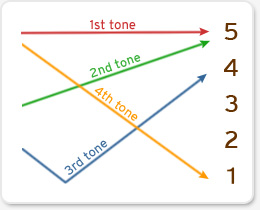Chinese Pronunciation
Pinyin Section 17

Tones

Mandarin Chinese is a tonal language. In order to differentiate meaning, the same syllable can be pronounced with different tones. Mandarin's tones give it a very distinctive quality, but the tones can also be a source of miscommunication if not given due attention.
Mandarin is said to have four main tones and one neutral tone (or, as some say, five tones). Each tone has a distinctive pitch contour which can be graphed using the Chinese 5-level system.
First Tone
The first tone is high and level. It is important to keep one's voice even (almost monotone) across the whole syllable when pronouncing the first tone. It is represented by a straight horizontal line above a letter in pinyin (or sometimes by a number "1" written after the syllable).
Try listening to the following first tone syllables:
| Syllable | Play | Syllable | Play |
| mā | yī | ||
| lē | hōu | ||
| bō | kōng | ||
| nāo | yū |
Second Tone
The second rises moderately. In English we sometimes associate this rise in pitch with a question. The second tone is represented by a rising diagonal line above a letter in pinyin (or sometimes by a number "2" written after the syllable).
Try listening to the following second tone syllables:
| Syllable | Play | Syllable | Play |
| má | yí | ||
| lé | hóu | ||
| bó | kóng | ||
| náo | yú |
Third Tone
The third tone falls and then rises again. When pronounced clearly, its tonal "dipping" is very distinctive. It is represented by a curved "dipping" line above a letter in pinyin (or sometimes by a number "3" written after the syllable).
Try listening to the following third tone syllables:
| Syllable | Play | Syllable | Play |
| mǎ | yǐ | ||
| lě | hǒu | ||
| bǒ | kǒng | ||
| nǎo | yǔ |
Fourth Tone
The fourth tone starts out high but drops sharply to the bottom of the tonal range. English-speakers often associate this tone with an angry command. It is represented by a dropping diagonal line above a letter in pinyin (or sometimes by a number "4" written after the syllable).
Try listening to the following fourth tone syllables:
| Syllable | Play | Syllable | Play |
| mà | yì | ||
| lè | hòu | ||
| bò | kòng | ||
| nào | yù |
Neutral Tone
The neutral tone is not mapped on the tone chart because it differs from the other four tones in that it does not have a defined pitch contour. The neutral tone is pronounced quickly and lightly without regard to pitch. Syllables with a neutral tone have no tone mark (but are sometimes marked with a "5" or a "0" after the syllable).
This tone is usually very easy to pick up. Note that aside from grammatical particles, single syllable words cannot have a neutral tone.
Try listening to the following neutral tone syllables:
| Syllable | Play | Syllable | Play |
| ma | yǐzi | ||
| le | hóuzi | ||
| bózi |
Tone Rule #1: 3-3 to 2-3
When there are two third tones in a row, the first one becomes second tone. This rule is always followed, automatically, even though it will not be reflected in the pinyin.
Try listening to the following examples:
| Originally | After applying the rule | Play |
| 你好 (nǐ + hǎo) | 你好 (ní hǎo) | |
| 很好 (hěn + hǎo) | 很好 (hén hǎo) | |
| 好懂 (hǎo + dǒng) | 好懂 (háo dǒng) |
There is also a podcast about this tone rule: Two Third Tones.
Tone Rule #2: 不
When the word 不 (bù) precedes a fourth tone, 不 changes to second tone (bú). This rule is always followed, automatically, even though it will not be reflected in the pinyin.
Try listening to the following examples:
| Originally | After applying the rule | Play |
| 不对 (bù + duì) | 不对 (bú duì) | |
| 不去 (bù + qù) | 不去 (bú qù) | |
| 不错 (bù + cuò) | 不错 (bú cuò) |
Tone Rule #3: 一
The character 一 (yī), meaning "one," is first tone when alone, second tone when followed by a fourth tone, and fourth tone when followed by any other tone. This rule is always followed, automatically, even though it will not be reflected in the pinyin.
Try listening to the following examples:
| Originally | After applying the rule | Play |
| 一个 (yī + gè) | 一个 (yí gè) | |
| 一次 (yī + cì) | 一次 (yí cì) | |
| 一半 (yī + bàn) | 一半 (yí bàn) | |
| 一般 (yī + bān) | 一般 (yì bān) | |
| 一毛 (yī + máo) | 一毛 (yì máo) | |
| 一百 (yī + bǎi) | 一百 (yì bǎi) |